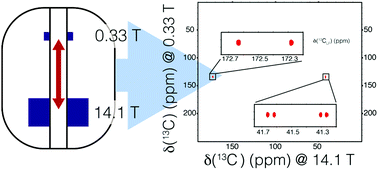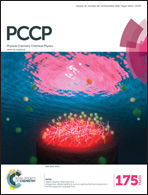High-resolution two-field nuclear magnetic resonance spectroscopy†
Abstract
Nuclear magnetic resonance (NMR) is a ubiquitous branch of spectroscopy that can explore matter at the scale of an atom. Significant improvements in sensitivity and resolution have been driven by a steady increase of static magnetic field strengths. However, some properties of nuclei may be more favourable at low magnetic fields. For example, transverse relaxation due to chemical shift anisotropy increases sharply at higher magnetic fields leading to line-broadening and inefficient coherence transfers. Here, we present a two-field NMR spectrometer that permits the application of rf-pulses and acquisition of NMR signals in two magnetic centres. Our prototype operates at 14.1 T and 0.33 T. The main features of this system are demonstrated by novel NMR experiments, in particular a proof-of-concept correlation between zero-quantum coherences at low magnetic field and single quantum coherences at high magnetic field, so that high resolution can be achieved in both dimensions, despite a ca. 10 ppm inhomogeneity of the low-field centre. Two-field NMR spectroscopy offers the possibility to circumvent the limits of high magnetic fields, while benefiting from their exceptional sensitivity and resolution. This approach opens new avenues for NMR above 1 GHz.



 Please wait while we load your content...
Please wait while we load your content...